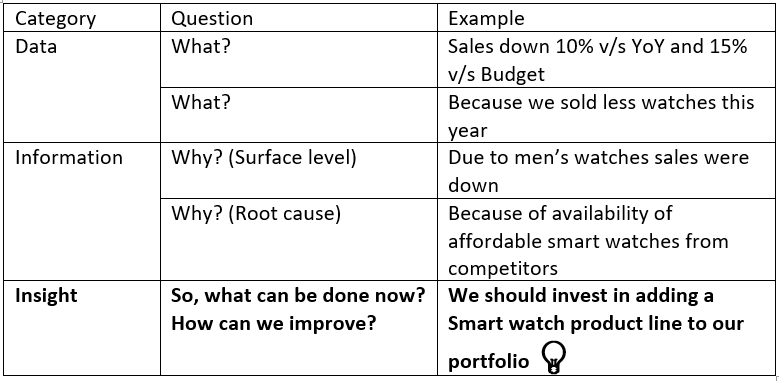
Data can be a valuable asset for businesses. But data alone, without actionable insights, has limited value. This is an important FP&A skill set. And helps in making the management reports more useful.
Here are 3 tips to help make that transformation:
1. Understanding the difference between data, information and actionable insights.
Data is raw numbers. Information is processed and structured data. Insight is actionable information or a valuable recommendation.
Example: Here is an example of a company which sells 3 products. Jewelry, Watches and Eyewear.

Most often, we make the mistake of calling structured data as information or a beautifully designed chart or graph as insight. Both are just data. Even beautiful designed dashboards are just data unless they give the commercial drivers or the root causes.\
2. Use The 5 Why Technique
While we work with information, we come across 2 types of why’s
i) Surface level why’s and
ii) Deeper level, which are the root causes why.
Most people only get to surface why.
The 5 why’s is a technique used to identify the root commercial driver of a problem during variance analysis. The technique consists of asking a “why” question 5️ times, with each “why” representing one level of depth.
The idea behind it is to go beyond the surface level reasons and find the root commercial drivers for the variances, and then recommend corrective measures, if necessary.
Example:
1. Why are total revenues lower 📉 than expected❓
The revenues from the “XYZ” department were lower than planned.
2. Why are the revenues for “XYZ” department lower than planned❓
We offered big discounts in that category which was way higher than planned.
3. Why did we offer discounts so much higher than expected❓
The sales team ran a sales promotion for a number of products being heavily discounted.
4. Why did the sales team run a sales promotion for those products❓
This was done in order to clear old stock as there were numerous slow-moving products.🐢
5. And why did we have to do that?
Demand for these products was not as strong as expected.
3. Build relationships with various business stakeholders and ask effective questions.
This will help you get to the root causes or the commercial drivers.You won’t be able to do that sitting on your desk in front of your computer. For that, you will need to talk to various people in the organization.
Here is a quick summary of the 3 tips to turn data into actionable insights.
1. Understanding the difference between Data, Information and Insights.
2. Use the 5 Why Techniques.
3. Build relationships with various business stakeholders and ask effective questions.
